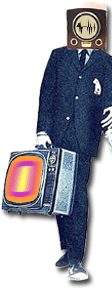

A Mun's family is moving to Edmonton where they are to open a restaurant but A Mun wishes to remain in Montreal pursuing her career as an artist. Her decision creates conflict within the family circle, especially with her oIder sister who believes in traditional family values. Silence into Silence speaks of the difficulties of assuming one's own voice, that of A Mun, her older sister and of the mother. Produced in Cantonese and English.
Silence into Silence
3/4" videotape, 26:00 min., colour, stereo 1989
Distributor: Le Videographe Inc.
Chinese Cafes is a documentary made for television, educational institutions, home viewing and ethnic interests. It unlocks the swinging doors of Chinese cafes in small town and country Saskatchewan. It looks at the people behind the businesses and the cafes within the community. Chinese Cafes features Wayne Mah, the first Chinese mayor on the Canadian Prairies, the Kook family in Outlook, Sask. and the Tang family from Humboldt. They reveal their views on race relations, gender roles and small town rivalries.
Chinese Cafes in Rural Saskatchewan
3/4" videotape, 26:06 min., colour, sound 1985
Distributor: Video Out
Chinese Characters examines the ambiguous relationship between gay Asian men and gay white porn. Through fantasy voice-overs, staged interviews and humourous re-enactments of scenes from porn classics, the tape forces viewers to question their own narrow definitions of what constitutes gay desire. The images are of classically "Chinese" framed flowers set within the role modelling of trying on various "gay" costumes.
Chinese Characters
3/4" videotape, 20:38 min., colour, sound 1986
Distributor: V Tape
Rage is an edited video documentation of a performance. In this work Hirabayashi uses dance, music and historical photographs in a video format to portray the emotional response of third generation Japanese Canadians to internment. During WWII, Canada branded some 22,000 Canadians of Japanese origins as "enemy aliens", confiscated their land, personal property and businesses, and deported them to internment camps in the interior.
Rage
3/4" videotape, 25:00 min., colour, stereo 1988
The videotape is an improvised sound performance using voice and facial mime. Part I is an unedited performance. Part II is an edited version of another take. The editing is based on a system that gives to the "in and out points" of the base tape a sequential rhythm of expansion and contraction. The "inserts" which are selected from the same take also have a sequential rhythm of expansion and contraction but in a different time frame. The result is an interaction of two separate rhythm patterns constantly moving toward, meeting, or moving away from each other. The work is influenced by Japanese opera, Korean court music, jazz, scat and concrete poetry.
Nobuo Kubota at the Western Front. Part II
3/4" videotape, 14:00 min., colour, stereo 1990
Distributor: Western Front Video
Images of power and crises are orchestrated over Ezra Pound's translations of Confucius' Great Digest, ancient stone tablets. "To seek harmony in the nation, one must first of all put their own house in order. To put their own house in order, one must seek precise verbal definitions of the ineffable".
5000 Years of Good Advice
3/4" videotape, 12:00 min., colour, sound 1987
Distributor: Video Out
It is June 12, 1986, a hot and sweaty day in Luneta Park, Manila. The tape is a closeup recording of an impromptu celebration over the fall of Marcos. Scantily dressed men with body paint form the drum corps in a loose circle around men in grass skirts, costumes and loin cloths. Some of them are painted blue, some appear cross-dressed in contemporary Western makeup. It is an odd pagan/late 20th century high energy ritual. They dance provocatively to the rhythm of the drums. They jostle with each other and for the camera. It is fun and they are happy.
Ati Ati Han
3/4" videotape, 7:50 min., colour, sound 1986
Distributor: Video Out
It is never clear where the journey referred to will lead although the voiceover continually intones: "I always knew that I would have to go home one day."
1) The Egg: containing the germ of the new individual.
2) The Ritual: with respect for ceremony, the traveller uses her body to create a path between distance and destiny.
3) The Path: a chosen walk place for use by people on foot.
The Journey
3/4" videotape, 7:45 min., colour, sound 1986
Distributor: Video Out